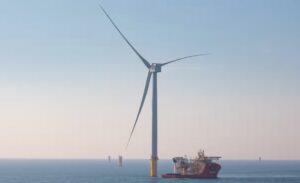A predicted investment of over $US100 billion ($A139 billion) in solar and wind power over the next decade is expected to take Japan beyond its renewable target to a share of 27% of the country’s energy mix.
Japan had set itself a target of pushing the renewable share of its energy mix to between 22% and 24% by 2030, according to its 5th Strategic Energy Plan.
A country traditionally dominated by nuclear power, renewables accounted for 19% of Japan’s power generation in 2019, which included around 8% of wind and solar.
Analysts at energy consultancy Wood Mackenzie, however, expect significant investment to result in Japan overshooting their renewable target.
“We estimate over US$100 billion of solar and wind power investments in Japan between 2020 and 2030, a significant boost to the renewables sector,” said Wood Mackenzie research director Alex Whitworth this week.
“Even before recent announcements looking to accelerate retirements of coal power, Japan had a clear pathway to meet its 2030 renewable power target. Lower demand expectations are now aligning with falling renewables costs to accelerate Japan’s shift away from fossil fuels.”
The increase in investment will be accompanied by a decrease in wind and solar generation costs in Japan, which Wood Mackenzie expects will drop by over 30% over the coming decade. As renewables grow ever more competitive with fossil fuels in Japan, major investment opportunities will rear their head, even at the same time as government-backed subsidy levels decline.
Already a world leader in distributed solar power, with over 45GW deployed to date, Japan has also begun to look to offshore wind to provide renewable power generation to an otherwise isolated island country. Wood Mackenzie expects offshore wind to grow “exponentially” in the coming decade, reaching around 8GW by 2030.
“The elephant in the room is coal power which currently supplies about a third of Japan’s power and will continue to be the cheapest power supply option in Japan even beyond 2030,” said Whitworth.
“The next decade will be a balancing act to manage the growth of renewables to reach environmental and energy security goals while keeping end-
user power tariffs stable.
“Fortunately, power supply costs in Japan have dropped by over 15% this year due to the coronavirus pandemic and oil price crash. This is a boon for Japan and should help the country more than double the share of wind and solar in the generation mix to 18% by 2030 without putting upward pressure on consumer power bills.”
Solar and wind are significant tools Japan will use to extricate itself from its reliance upon coal power and nuclear reliance, but Japan was also one of the first countries in the world to announce a hydrogen strategy and is now currently the sixth-largest hydrogen market.
With hydrogen demand expected to hit 4.02 million metric tonnes this year, and with close to 90% of demand coming from refineries, Japan’s hydrogen supply as yet has not begun transitioning to clean energy and is heavily emissions-intensive.
This will have to change, and quickly, as the mobility sector forms a major portion of the country’s hydrogen goals. Specifically, Japan is planning 200,000 fuel cell vehicles (FCVs) by 2025 and 800,000 by 2030 – up from a current fleet of only 4,000.
“Hydrogen fuel cell cars are 30% more expensive than electric vehicles,” said Wood Mackenzie research director Prakash Sharma. “Without rapid cost declines and continued government support in rolling out refuelling infrastructure, FCV targets seem challenging to achieve in the timeframe.
“Cost is the biggest challenge because green hydrogen currently costs 2-4 times more than fossil-fuel hydrogen. The focus on hydrogen adoption makes perfect sense though because Japan has very few other options to reduce its non-power carbon emissions.
“Japan aims to lower green hydrogen price to US$3/kg by 2030. This would require the levelised cost of renewable electricity to fall under US$50 per megawatt-hour, an additional 37% reduction from the current forecast for domestic solar and wind plants. As a result, we expect Japan to pursue all options to procure clean hydrogen, including import of green and blue hydrogen.”
Interestingly, Wood Mackenzie expects that Australia “is set to benefit from Japan’s hydrogen ambitions” thanks to its “vast renewable energy potential, falling costs, improvements in electrolyser technologies and carbon capture and storage advancements.”
Wood Mackenzie predicts Australia “is likely to become a crucial partner with established trade relationships and logistics pathways under development.”








